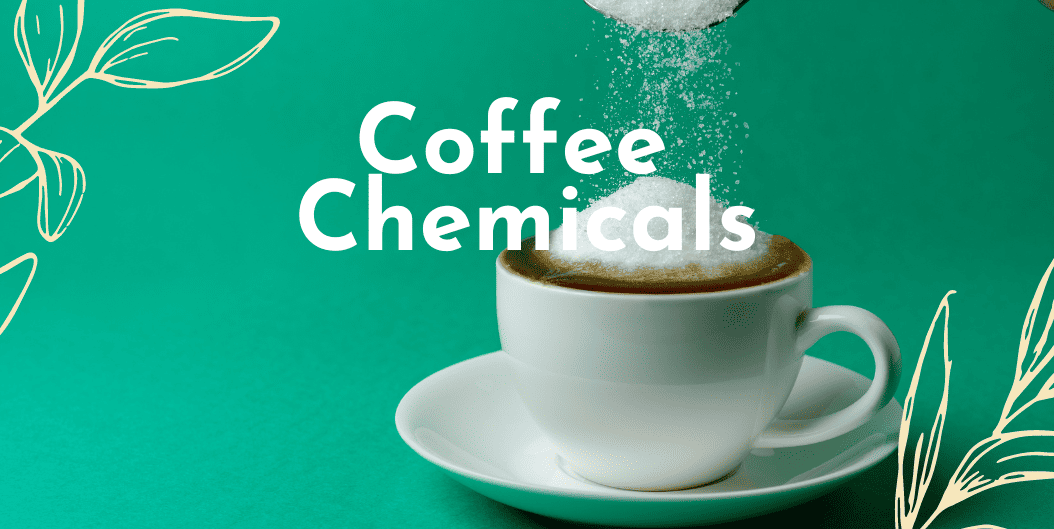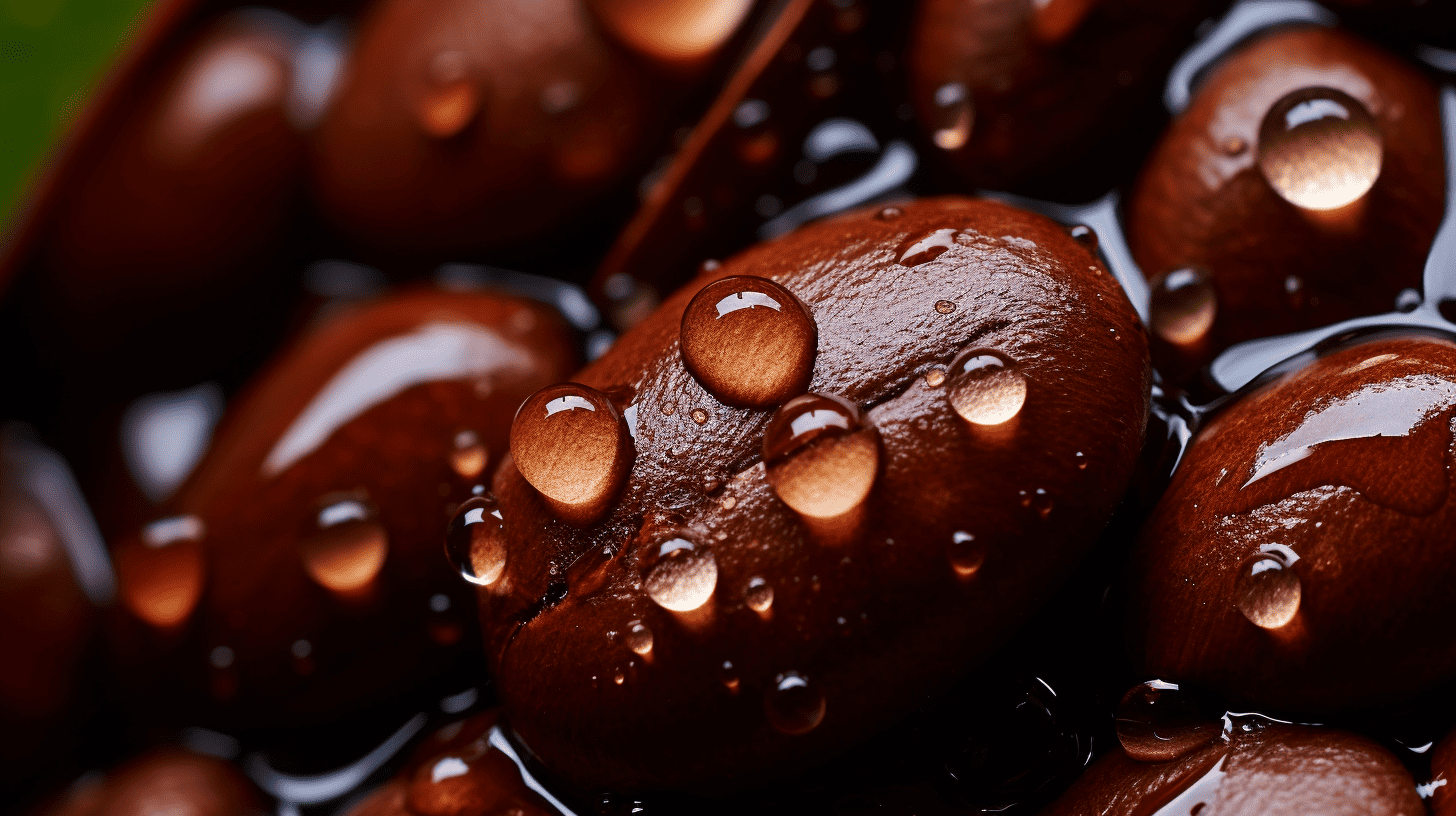Coffee is a popular beverage enjoyed by millions of people worldwide, but we must look at the harmful chemicals in coffee. It’s a great way to start your day, stay alert during work, or catch up with friends over a cup of joe. However, many people don’t know that coffee contains several harmful chemicals that can negatively impact human health.
One such chemical is acrylamide, formed during roasting and classified as a carcinogen by the International Agency for Research on Cancer (IARC). Exposure to acrylamide through coffee consumption can increase your risk of developing cancer.
Another harmful chemical found in coffee is caffeine. While caffeine can boost energy and improve mental focus when consumed in moderation, excessive intake can cause adverse effects such as anxiety, insomnia, and heart palpitations.
Mycotoxins are yet another group of harmful chemicals found in coffee. These toxins are produced by fungi that grow on coffee beans and can cause various health problems, such as liver damage and immune system suppression.
Polycyclic aromatic hydrocarbons (PAHs) are also present in coffee due to the high temperatures used during roasting or brewing. Exposure to PAHs has been linked to cancer and other health issues.
Despite the potential risks associated with consuming coffee containing these harmful chemicals, many people continue to drink it regularly without being aware of the potential harm they may be causing themselves.
It’s essential for consumers to educate themselves about the potential risks associated with consuming these harmful chemicals found in their daily cups of coffee. By doing so, they can make informed decisions about their health and well-being.
Harmful Chemicals in Coffee: An Overview
Acrylamide: The Most Well-Known Harmful Chemical in Coffee.
Acrylamide is a chemical formed when coffee beans are roasted at high temperatures. It is also found in other foods such as potato chips, french fries, and bread. Acrylamide has been classified as a carcinogen by the International Agency for Research on Cancer (IARC). This means that it has the potential to cause cancer in humans.
Studies have shown that acrylamide can cause damage to DNA and increase the risk of developing cancer. In animal studies, exposure to high levels of acrylamide has been linked to an increased risk of tumors in multiple organs, including the lungs, liver, and thyroid gland. However, it’s important to note that these studies were conducted using much higher doses than what would be consumed through regular dietary intake.
While there is no clear evidence linking coffee consumption with increased cancer risk in humans, it’s still important to be aware of the potential risks associated with acrylamide. Consider drinking lighter roasts or switching to alternative beverages such as tea or water to minimize exposure to this harmful chemical.
Caffeine: A Potentially Harmful Compound Found in Coffee
Caffeine is a naturally occurring compound found in the coffee bean. While moderate caffeine consumption (up to 400mg per day) is generally considered safe for most people, consuming too much caffeine can have negative effects on health.
Some common side effects of excessive caffeine consumption include insomnia, anxiety, jitteriness, and rapid heart rate. High levels of caffeine intake have been linked with an increased risk of cardiovascular disease and osteoporosis.
It’s important to note that individual tolerance levels for caffeine can vary greatly depending on age, weight, and overall health status. If you’re experiencing negative side effects from consuming coffee or other caffeinated beverages, consider reducing your intake or switching to decaf options.
Diterpenes: Another Potentially Harmful Compound Found in Coffee
Diterpenes are a group of compounds found in coffee that have been shown to increase LDL (bad) cholesterol levels in the body. High levels of LDL cholesterol can increase the risk of developing cardiovascular disease.
While diterpenes are present in all types of coffee, they are found in higher concentrations in unfiltered coffee such as French press or espresso. Consider drinking filtered coffee or switching to alternative beverages to minimize exposure to these harmful compounds.
Acrylamide: A Carcinogenic Chemical Found in Coffee
What is Acrylamide?
Acrylamide is a chemical that can form naturally in certain foods, including coffee, during high-temperature cooking processes such as frying, baking, and roasting. It is created when sugars and an amino acid called asparagine react at temperatures above 120°C (248°F). This chemical compound is commonly used in industrial settings to produce polymers and copolymers in plastics, grouts, water treatment systems, and cosmetics.
Probable Human Carcinogen
The International Agency for Research on Cancer (IARC) classifies acrylamide as a Group 2A carcinogen. This means that it is “probably carcinogenic to humans,” based on studies conducted on laboratory animals exposed to high levels of acrylamide. Although no conclusive studies link acrylamide exposure to cancer risk in humans, the IARC advises that reducing exposure to this chemical may help lower the risk of developing cancer.
Cancer Risk Associated with Acrylamide
Studies have found that acrylamide may increase the risk of several types of human cancers. The National Toxicology Program (NTP) has reported that acrylamide causes tumors in rats and mice exposed to high levels of this chemical through their drinking water. In humans, epidemiological studies have suggested an increased risk of breast, liver, and colorectal cancer associated with higher dietary intake of acrylamide.
How to Avoid Acrylamide
Coffee drinkers can reduce their exposure to acrylamide by choosing roasted coffee for a shorter period or by switching to decaf coffee. Darker roasts tend to contain more acrylamide than lighter ones because they are burned for extended periods at higher temperatures. Storing coffee beans properly can help reduce the formation of acrylamide. Coffee beans should be stored in a cool, dry place away from sunlight and moisture.
Polycyclic Aromatic Hydrocarbons (PAHs) in Coffee: Health Risks and Sources
Sources of PAHs in Coffee: Roasting and Brewing Methods.
The roasting process of coffee beans is a significant source of PAHs in coffee. When the organic matter in the beans is burned, it produces these harmful chemicals. The longer the roasting time, the higher the levels of PAHs. Darker-roasted coffee tends to have more PAHs than lighter-roasted coffee.
However, roasting isn’t the only factor contributing to coffee PAHs. Brewing methods can also play a role. For example, boiling or percolating coffee can lead to higher PAH levels than other brewing methods like drip or French press.
To reduce exposure to PAHs in coffee, consider choosing lighter roasted beans and using a low-temperature brewing method like drip or French press.
Health Risks Associated with Exposure to PAHs
Exposure to high levels of PAHs has been linked to an increased risk of cancer and other health problems. According to the International Agency for Research on Cancer (IARC), several types of cancer are associated with exposure to PAHs, including lung and skin cancer.
Studies have found that exposure to high PAH levels may be linked to respiratory problems like asthma and decreased lung function. Pregnant women exposed to high levels of PAHs may also be at risk for adverse pregnancy outcomes such as low birth weight and preterm delivery.
Reducing Your Exposure to PAHs in Coffee
While it’s impossible to eliminate your exposure to PAHs in coffee completely, there are steps you can take to reduce your risk:
Mycotoxins in Coffee: What Are They and How to Avoid Them?
Mycotoxins are toxic substances molds produce that can contaminate coffee beans during growth, processing, and storage. These toxins can harm human health, including liver damage, immune system suppression, and cancer. Aflatoxin B1 is a type of mycotoxin commonly found in coffee that has been linked to various health issues. Ochratoxin is another mycotoxin that can be present in coffee and has been associated with kidney damage.
Choose High-Quality Beans from Reputable Sources
Choosing high-quality beans from reputable sources is essential to avoid mycotoxins in coffee. When purchasing coffee beans, look for those certified as organic or fair trade. These certifications ensure that the beans have been grown and processed without harmful chemicals or pesticides. Buying directly from small-scale farmers who grow their coffee can also help reduce the risk of mycotoxin contamination.
Store Beans Properly
Storing coffee beans properly is also crucial for avoiding mycotoxins. It is recommended to store them in a cool and dry place away from sunlight and moisture. Airtight containers are ideal for maintaining freshness and preventing mold growth. Keep your coffee equipment clean since mold can grow on dirty equipment.
Brew Using Clean Equipment
Finally, brewing your coffee using clean equipment is crucial for avoiding mycotoxins. Make sure to clean your equipment regularly with hot water and soap or vinegar to prevent mold growth. Use filtered water when brewing since tap water may contain contaminants that could increase the risk of mycotoxin contamination.
Chlorogenic Acid: Is It Harmful or Beneficial?
Health enthusiasts and coffee lovers have been buzzing about chlorogenic acid, a natural compound in coffee beans. This polyphenol has been linked to various health benefits and potential risks. This section will explore the latest research on chlorogenic acid and its effects on the body.
The Benefits of Chlorogenic Acid
Studies have shown chlorogenic acid may help reduce inflammation, lower blood pressure, and improve glucose metabolism. One study published in the Journal of Agricultural and Food Chemistry found that chlorogenic acid could inhibit the growth of colon cancer cells in vitro. Another study published in the Journal of Nutrition showed that consuming green coffee extract rich in chlorogenic acid improved insulin sensitivity and reduced blood sugar levels in overweight individuals.
Chlorogenic acid is a potent antioxidant that can help protect against oxidative stress caused by free radicals. Free radicals are unstable molecules that can damage cells and contribute to aging and disease.
The Risks of Chlorogenic Acid
While chlorogenic acid consumption has many potential benefits, some research suggests that high doses may adversely affect the body. A study published in Food & Function found that high amounts of chlorogenic acid increased the risk of heart disease in rats by promoting lipid peroxidation (the breakdown of fats). Another study published in Nutrients showed that consuming high doses of green coffee extract containing chlorogenic acid increased markers for oxidative stress in healthy adults.
It’s important to note that most studies showing adverse effects used very high doses of chlorogenic acid – much higher than what would be consumed through regular dietary intake or moderate coffee consumption. Other compounds in green coffee extract may have contributed to these adverse effects.
Moderation is Key
As with many things related to diet and health, moderation is vital; darker roasts have lower levels of chlorogenic acid than lighter roasts. Espresso-based drinks tend to have higher levels of chlorogenic acid than drip coffee.
It’s also important to consider the overall quality of your coffee. Opting for organic, fair-trade coffee can help ensure you’re not consuming harmful chemicals, pesticides, chlorogenic acid, or other chemicals.
Pesticides in Coffee: How They Affect Your Health and the Environment
The use of pesticides and herbicides in coffee farming is a common practice to control pests and weeds. However, this can leave harmful pesticide residue on the beans, adversely affecting human health and the environment. Glyphosate, a commonly used herbicide in coffee farming, has been linked to various health problems, such as cancer. Fertilizers in coffee farming can contribute to environmental damage, such as soil erosion and water pollution.
Glyphosate: A Common Herbicide Used in Coffee Farming
Glyphosate is a widely used herbicide in coffee farming due to its effectiveness against weeds. However, it has been linked to numerous health problems like cancer. Some studies have shown that glyphosate exposure may increase the risk of developing non-Hodgkin’s lymphoma by up to 41%. Moreover, glyphosate can also harm beneficial insects like bees, which are essential for pollination.
Fertilizers: Contributing Factors to Environmental Damage
Fertilizers are often used in coffee farming to provide nutrients for plant growth. However, they can also contribute significantly to environmental damage. The excessive use of fertilizers can lead to soil erosion which causes loss of topsoil and reduces soil fertility. Furthermore, excess fertilizer runoff into water bodies can cause eutrophication, leading to an overgrowth of algae that depletes oxygen levels needed by aquatic life.
Pesticide Residue: Negative Effects on Human Health
People who consume coffee with high levels of pesticide residue may experience adverse health effects, including headaches, nausea, and even neurological problems. Pesticide residues from coffee consumption have also been linked with developmental delays among children exposed prenatally or during early childhood. Therefore, consumers must be aware of the potential risks of consuming coffee containing pesticide residues.
Balancing Crop Protection with Potential Harm to Human Health and the Environment
The problem of pesticide use in coffee farming is complex. It requires a careful process of balancing the need for crop protection with the potential harm to human health and the environment. Farmers can adopt integrated pest management practices that minimize the use of pesticides while still protecting crops from pests and diseases. Consumers can choose organic or shade-grown coffee, which are grown without the use of synthetic pesticides or fertilizers.
Heavy Metals in Coffee: Risks and Prevention Measures
Due to soil contamination and the roasting process, trace amounts of heavy metals such as lead and cadmium can be found in coffee. Although these levels are generally considered safe for consumption, exposure to these heavy metals can pose health risks, including damage to the kidneys, liver, and nervous system. In this section, we will discuss the risks associated with heavy metals in coffee and explore some prevention measures that you can take.
Stainless Steel Equipment
Using stainless steel equipment during coffee-making can help prevent heavy metal contamination. Stainless steel is a non-porous material that does not react with acidic substances like coffee. This means it does not leach harmful chemicals or metals into your brew. When purchasing equipment for your home or business, look for options made from high-quality stainless steel.
Roasting Process
The roasting process can also affect the levels of heavy metals found in coffee. Roasting at high temperatures or for extended periods can increase these metals’ concentration. Monitoring the roasting process carefully is essential to ensure it is done safely and effectively. Using a thermometer to track the temperature and timing each roast accurately can help you maintain control over this aspect of production.
Amounts
While trace amounts of heavy metals are present in most foods, including fruits, vegetables, grains, meats, and dairy products, monitoring your overall consumption is essential. If you’re drinking several cups of coffee daily or consuming other foods with higher concentrations of heavy metals regularly (such as certain types of fish), you may want to consider reducing your intake or seeking alternative sources.
Prevention Measures
There are several steps that you can take to reduce your risk of exposure to heavy metals through coffee consumption:
Alternatives to Conventional Coffee: Safer Options for Your Health
Coffee is a beloved beverage for millions of people around the world. However, some individuals may be concerned about the potential health risks associated with conventional coffee due to harmful chemicals in its production. Luckily, there are alternatives to traditional coffee that offer a safer option for your health.
Coffee Substitutes: A Caffeine-Free Alternative
If you’re seeking a caffeine-free alternative to conventional coffee, consider substitutes such as chicory root, roasted dandelion root, and barley malt. These options provide a similar taste and aroma without the stimulating effects of caffeine. They offer several health benefits, such as aiding digestion and reducing inflammation.
Organic Coffee: A Safer Option
Organic coffee is an excellent option for those who prefer traditional coffee but want to avoid harmful chemicals. Organic coffee beans are grown without synthetic pesticides or fertilizers that can harm both human health and the environment. Look for organic certification labels on packaging when purchasing organic coffee.
Decaf Coffee: A Low-Caffeine Solution
Decaf coffee is another safe option for those who want to enjoy traditional coffee without consuming too much caffeine. However, not all decaf coffees are created equal. During decaffeination, some decaf coffees use harsh chemicals like methylene chloride or ethyl acetate, which can leave harmful residues on the beans. Look for decaf coffees that use the Swiss Water Process instead, which uses only water and activated carbon filters to remove caffeine.
Instant Coffee and Coffee Pods: Potential Health Risks
Instant coffee and single-use pods may seem convenient when you drink coffee, but they come with potential health risks due to their manufacturing process. Instant coffees are often made from lower-quality beans that have been over-roasted and then spray-dried at high temperatures. In animal studies, this can lead to acrylamide formation – a carcinogenic chemical compound linked to cancer risk. Similarly, single-use pods can contain plastic and aluminum, which can leach into the coffee during brewing. It’s best to avoid these products altogether and instead brew your coffee using hot water and organic coffee beans.
Drinking Water Quality: Affecting Taste
The water quality used to brew your coffee can also affect its taste. Using filtered water ensures that any impurities or chemicals won’t interfere with the flavor of your coffee. Consider using reusable cups or bags when purchasing coffee to reduce waste from single-use products.
The Importance of Safe Consumption of Coffee
Safe coffee consumption is essential for maintaining good health. The amount of coffee intake should be monitored to avoid harmful effects on the body. Drinking coffee in moderation can provide benefits such as increased alertness and improved mood. The US government has set guidelines for safe coffee consumption, including recommendations on the maximum caffeine intake per day.
Benefits of Moderate Coffee Consumption
Drinking morning coffee is a daily ritual for many people worldwide. It is not just about the taste or packaging; it also provides several health benefits when consumed in moderation. According to research, moderate coffee consumption can reduce the risk of heart disease, type 2 diabetes, liver cancer, Parkinson’s disease, and Alzheimer’s disease.
Coffee contains caffeine that stimulates the central nervous system and helps you stay awake and alert. It also improves cognitive function by increasing attention span, memory retention, and reaction time. Furthermore, drinking coffee can elevate your mood by releasing dopamine and serotonin hormones that make you happy and relaxed.
Guidelines for Safe Coffee Consumption
The US government has set guidelines for safe coffee consumption to prevent adverse health effects caused by excessive caffeine intake. Current research shows adults should consume no more than 400 milligrams of caffeine per day, equivalent to four cups of brewed coffee or ten cans of soda.
It is essential to monitor your caffeine intake because excessive consumption can cause side effects such as anxiety, insomnia, restlessness, rapid heartbeat, high blood pressure, and digestive problems like acid reflux or diarrhea.
Choosing Safe Coffee Beans
When choosing roasted coffee beans or pre-packaged coffees from grocery stores or cafes, it’s crucial to look at labels carefully before purchasing them. Some brands add artificial flavors or chemicals that may harm your health.
Organic coffees are grown without pesticides or synthetic fertilizers, making them safer than conventional coffees that may contain harmful chemicals. Fair-trade certified coffees ensure that farmers are paid fairly and work under safe conditions. These certifications are essential to consider when purchasing coffee to ensure it is safe for consumption.
What Chemicals Are Present in Coffee Powder According to Your Analysis?
A detailed chemical analysis of coffee powder reveals the presence of several key compounds. Caffeine, a well-known stimulant, plays a central role in coffee’s effects. Other compounds include chlorogenic acids, which contribute to coffee’s acidity, and trigonelline, responsible for its unique aroma. Roasting also produces Maillard reaction products, which enhance flavor. Additionally, coffee contains antioxidants and small amounts of minerals like potassium and magnesium. Understanding these components helps us unveil the complexity of the beloved coffee beverage.
Conclusion: Harmful Chemicals in Coffee and the Importance of Safe Consumption
In conclusion, coffee is a widely consumed beverage containing various chemicals, some of which can harm human health. Acrylamide, polycyclic aromatic hydrocarbons (PAHs), mycotoxins, chlorogenic acid, pesticides, and heavy metals are the most concerning chemicals in coffee.
While these chemicals may pose health risks at high levels or with long-term exposure, studies suggest that they are generally safe for humans when consumed in small quantities within safety limits. However, it is essential to note that more human studies are needed to understand these chemicals’ effects on our healthfully.
To ensure safe consumption of coffee, it is recommended to choose high-quality beans from reputable sources and avoid blends with lower-quality beans. Using organic or fair-trade certified coffee can reduce exposure to harmful pesticides and heavy metals.
It is also essential to properly store and brew coffee to minimize the formation of acrylamide and other harmful substances. This includes keeping java in a cool, dry place away from light and air; grinding beans just before brewing; using filtered water; and avoiding over-roasting or burning the beans.
FAQs on Harmful Chemicals in Coffee Today
Q: What harmful chemicals can be found in coffee?
A: Coffee may contain harmful chemicals such as acrylamide, pesticides, herbicides, and mold toxins known as mycotoxins.
Q: How do harmful chemicals end up in coffee?
A: Harmful chemicals can be present in unroasted coffee beans or form during roasting or brewing processes. Pesticides and herbicides are often used in coffee bean cultivation.
Q: Do coffee bags contain harmful chemicals?
A: While coffee bags themselves don’t contain harmful chemicals, the coffee inside may have them if it comes from an unreliable source.
Q: Can coffee consumption be harmful to our health?
A: Although coffee offers numerous health benefits, drinking coffee with harmful chemicals can be detrimental to our health. For instance, acrylamide, a carcinogen, can cause cancer.
Q: Do different types of coffee have varying levels of harmful chemicals?
A: Yes, the levels of harmful chemicals can differ in various types of coffee depending on their growth, processing, and roasting methods.
Q: What is acrylamide, and why is it harmful?
A: According to the World Health Organization, Acrylamide is a carcinogenic chemical that forms when coffee beans are roasted at high temperatures.
Q: Is liquid coffee safer than ground coffee?
A: Liquid coffee isn’t necessarily safer than ground coffee, as both may contain harmful chemicals. It’s crucial to purchase coffee from trustworthy suppliers and opt for organic, pesticide-free options when possible.
Q: Is yeast harmful in coffee?
A: Yeast isn’t harmful in coffee and is often used during the coffee production’s fermentation process. However, improper coffee processing can lead to harmful mold growth, negatively impacting our health.





Leave a Reply